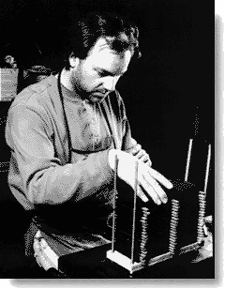[ Shop Tour: 1 2 3 4 5 ]
The woods used in OME instruments are first graded at the mill from rough sawn, select hardwoods. This lumber is later re-graded and the best boards are pulled and cut into billets. The ends are then sealed with wax and the lumber is air dried for several years before starting the long process of becoming an OME.
Fiddle back or curly maple form the neck, rim, and resonator of most of our models. We feel that this vibrant wood, with its flexible strength, unusual beauty, and balanced tone is the best all-around material for building banjos. Our second choice is Honduras mahogany which is stable, easy to work, and produces a sweet, warm tone. American walnut also works well and falls between maple and mahogany. Occasionally we use East Indian rosewood to produce instruments with an unusually bright and solid response.

After curing, the rough cut billets are milled into precision rectangular blocks, further aged, and finally band-sawed into oversize neck blanks. These blanks are left to stabilize for a period of time before they are further machined and then fitted with our lightweight, two-way adjustable tension/compression neck rods.
Over the years we have used different neck rods adjustable at either end of the neck. Our results have shown that the longer, heel adjusting rod which has the fixed end in the peghead, renders the neck stronger and gives a smoother, more consistent bend to the fingerboard than does the shorter peghead adjusting version.

We have also tried a variety of both double and single rod systems. We found that our single rod, with tension/compression action works the best. Although more difficult and costly to install, the single rod is lighter than the double and renders the neck more vibrant and resonant. It also bends the neck smoother and will not split the fingerboard as the double rods might do.
After the neck rod is installed, the Brazilian Rosewood or Gaboon ebony fingerboard and peghead overlay, and heel cap are glued in place.



